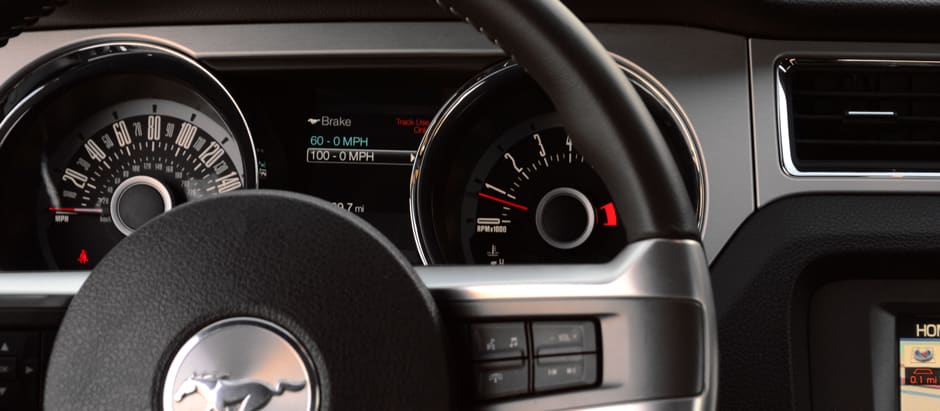Pros
Cons
Introduction
The 2013 Mustang takes a bit from each camp. The car itself is obviously a throwback, visually and mechanically. And while the latest Mustang is far too big to be a "pony car"—the class of small, inexpensive cars the original '64 birthed—its price is still true to its roots. You'll even find some cool tech inside and under the hood, though Ford's latest MyFord Touch infotainment setup isn't available.
Tech & Entertainment
The Mustang we drove wasn't the Boss 302 or the Shelby GT500. Heck, it wasn't even a V8-powered GT. It was a V6 Premium convertible with an automatic transmission, designed almost exclusively for cruising an open highway with the top down and a phone-ful of music at the ready.
As such, it's appropriate that our tester was also fitted with the Electronics Package, which gave it navigation, Ford's Sync, and wireless Bluetooth streaming. There's also Sync Apps, which lets the driver use Sync's voice commands to control certain apps such as Pandora and NPR. With the top down, it can feel a bit odd to shout, "NPR Programs!" and then "Morning Edition!" but it's a lot less awkward than taking a call from your mom with everyone in traffic around you able to hear.
{{photo_gallery "interior"}}
Pairing the phone was easy, and the system never once dropped our phone's connection mid-stream, which can't be said for some other Ford products that we've driven. Our only complaint was that the Shaker audio system lived up to its name, blasting out bass without any regard for what the car or speakers could handle.

Though a touchscreen featured prominently in the Mustang's center console, absent was the MyFord Touch (MFT) environment that's become popular on so many Ford vehicles. Instead, there's an older system that's decidedly less slick, swapping a three-panel 7-inch screen for MFT's four-quadrant 8-inch screen and lacking the customizable gauge cluster display. The chunky graphics are definitely dated, and there are some annoying quirks (why does the nav system prompt the user to enter a street first, even though it requires all searches to start by city?) but the setup is effective and we didn't have any major complaints. If you're not a fan of the look and feel of MyFord Touch, you should buy a Mustang now, as it's coming in the 2015 redesign.
Finally, there's Track Apps. You likely won't be taking your V6 convertible on the track, but if you do, there's a menu in the gauge cluster that lets you look at your 0-60 time, quarter mile, and brake performance. There's also an accelerometer. Just make sure you aren't doing anything stupid on public roads.
Design
Ford has hinted that the upcoming 2015 Mustang will be a complete redesign that's more faithful to the spirit of the original car than its physical form. That means you'll only have another year to get your hands on a Mustang that looks decidedly retro. Whether that makes you decide to put off a purchase or rush down to the dealership will depend on your own personal taste.
{{photo_gallery "exterior"}}
From the car's pronounced grill all the way back to the triple tail lamps, this car is visually recognizable as nothing else but a Mustang. Inside, we're less fond of design details that look decidedly kitschy, like a speedometer font that's supposed to echo a '60s era typeface but in reality is just impossible to read.
Our favorite touch: Sequential rear turn signals. The three lights blink individually, from the center outwards. On cars of the '60s and '70s, a physical motor would switch each lamp on and off in order to complete the sequential look. On the new car, it's all controlled electronically, but it still looks cool.
Driving Experience
The retro-modern theme continues with the Mustang's mechanicals
On most cars built since the mid-1990s, each rear wheel has had an independent suspension, and that's a good thing. Hit a bump, a patch of ice, or some water, and one wheel may spin, but the other one will retain traction. On the Mustang's live axle, a design that's become increasingly less common on passenger cars, both wheels are connected to each other. That means if one wheel gets into trouble, the other will follow. Lots of Mustang buyers want a car that's "tail happy," and it can be fun to let the rear of the car hang out in a turn, but it's something to keep in mind if you're choosing the car mostly for its looks and price.
Ford's engineers have done a lot to mitigate the live axle's shortcomings in real-world situations, and numerous track tests show the Mustang can hold its own against more refined cars. Still, we found it to be a liability, especially when driving on imperfect roads. Hit a bump in a turn, and you'll feel the back of the car slide out just a tiny bit. Even if you learned to drive during the Eisenhower administration, when nearly every car had a live rear axle, it may still a bit unnerving to feel that kind of handling imprecision in a modern car.
With that said, the Mustang's updated V6 is a revelation. It's as powerful as the V8s of just a few years ago, but much more refined and appropriate for the car's capabilities and aspirations. That's a blessing and a curse: Part of the reason the Mustang is so popular is the visceral joy of the optional V8 engine, from its burbling exhaust note to its take-no-prisoners power delivery. Ford did a decent job coaxing some swagger out of the V6, but you can only get that trademark throaty rumble from the larger engine.
We didn't see fuel economy numbers as high as the 23 combined mpg that EPA tests show, but c'mon—we've got a Ford Mustang convertible for a week. We're not going to drive like an official EPA tester. You probably won't either.
Conclusion
Nobody would ever say a Mustang is the most sensible, rational car purchase. However, recent updates make it a much more justifiable choice as a daily driver. With a more refined powerplant, sensible connectivity options, and a price that starts at $27,200 ($36,832 as tested), the V6 convertible is great for a long highway cruise on a sunny day, but it's also a fine choice for driving to work.
Trim Levels
The lowest-priced Mustang is the base V6 hardtop, which starts at $22,200. Option packages and special editions can push the price well over twice that amount.
If it's a V6 convertible you want, the price of entry is $27,200. To add options like the Electronics Package or upgraded seats, you'll need to step up to the V6 Premium Convertible, which starts at $31,200.
Powertrain
The V6 convertible has a 305 hp V6 engine and rear-wheel drive. It comes standard with a six-speed manual transmission, though you can get an optional six-speed automatic. The auto doesn't have paddle shifters — just a button on the side of the shifter that you press up and down if you want to choose your own gear.
Safety
Chopping the top off a car changes its body structure. That's why you have to look at crash tests for a convertible separately from the hardtop. NHTSA hasn't tested the Mustang convertible, but the Insurance Institute for Highway Safety has, and gave it an overall top "Good" rating for front- and side-impact tests. However, individual ratings for torso injury and structure/safety cage are "acceptable." It's not a Top Safety Pick.
Fuel Economy
With the V6 and an automatic, the Mustang convertible is EPA rated at 19 city, 30 highway and 23 combined. With the top and the throttle frequently down, we saw numbers much closer to that 19.
Meet the tester
Keith was the Editor in Chief of Reviewed's appliance and automotive sites. His work has appeared in publications such as Wired, Car & Driver, and CityLab.
Checking our work.
Our team is here to help you buy the best stuff and love what you own. Our writers, editors, and experts obsess over the products we cover to make sure you're confident and satisfied. Have a different opinion about something we recommend? Email us and we'll compare notes.
Shoot us an email

